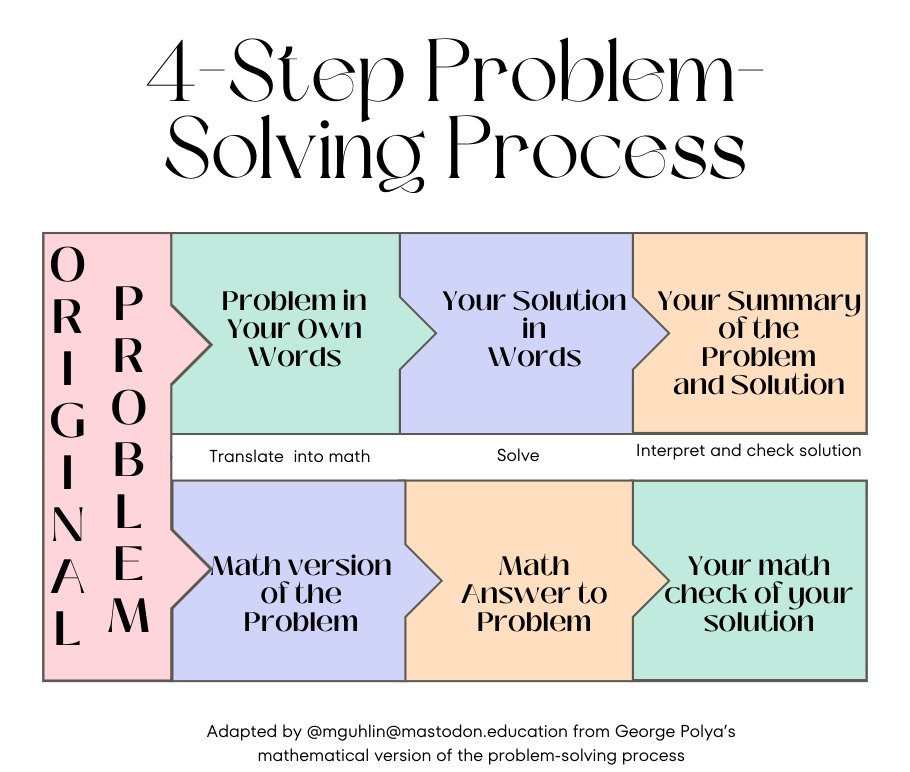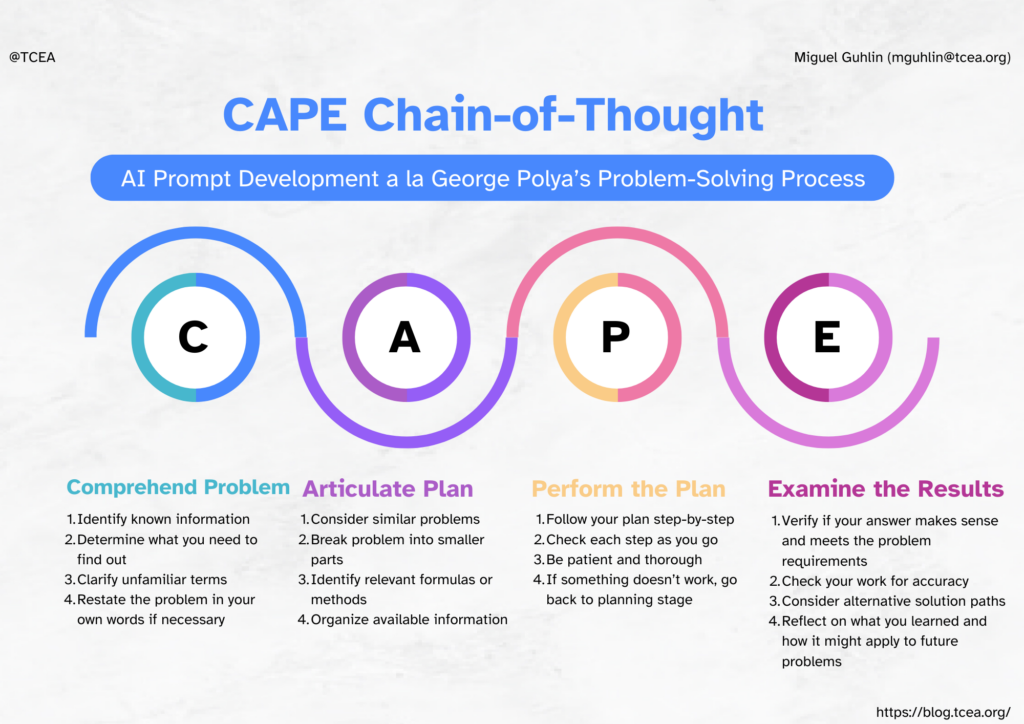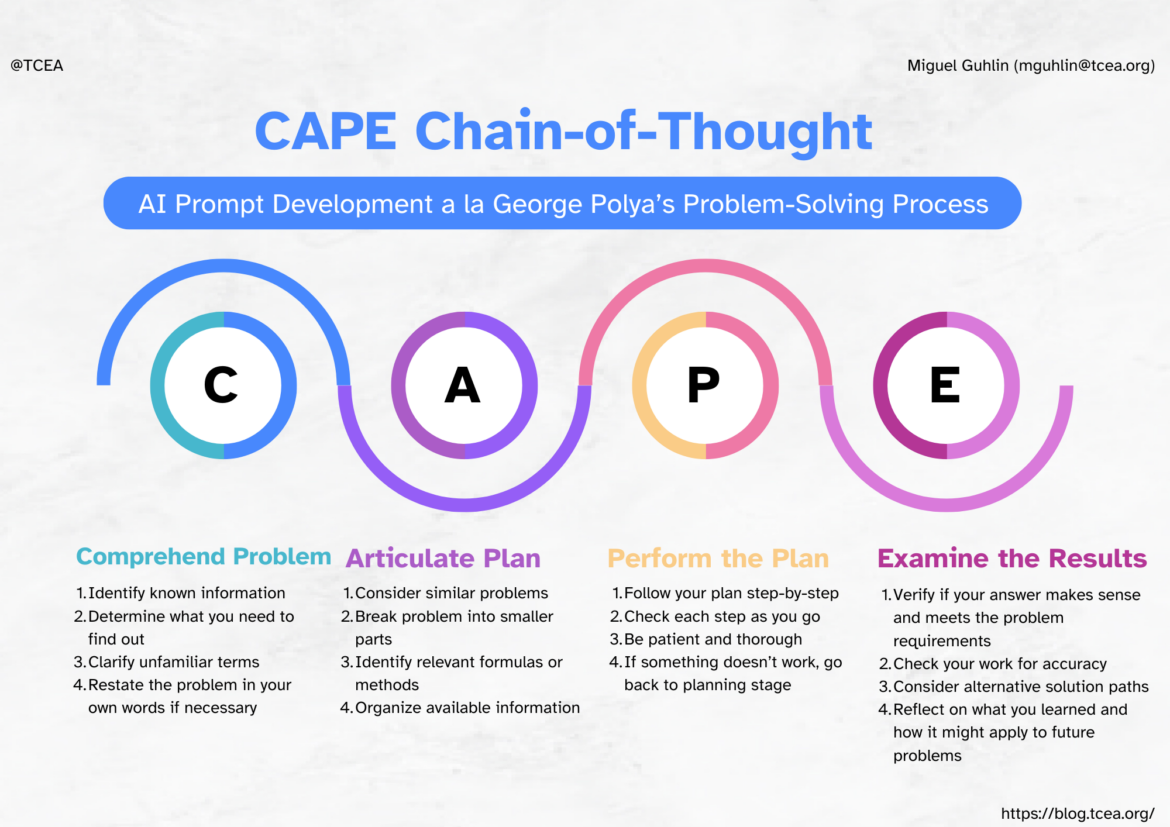What’s the best way to introduce decomposition to students? It might be simpler than you think! The term, decomposition, refers to breaking complex problems into simpler ones. In this way, you can solve problems that seem difficult, if not impossible, to resolve at first glance. So, then, why not combine decomposition with AI prompt development? Let’s explore how crafting AI-friendly, step-by-step processes can benefit learners. At the end of the blog entry, you will find an example of CAPE adaptation of a four-step problem-solving process to AI prompt development, or the CAPE AI Prompt Maker.
Decomposition by Any Other Name
“A rose by any other name would smell as sweet,” my father would often say. When you hear the word “decomposition,” you may think of trash, giving off a malodorous aroma as it rots. While trash rotting into bio-degradable components is one perspective, another exists. That alternate term is “chain-of-thought” (CoT for short).
Think of CoT as a way to enhance our reasoning by breaking down tough tasks into steps. Let’s first take a look at CoT in the context of educational settings.
#1 – Solving Math Problems
“I hate word problems!” You may have heard this utterance more than once, if not spoken it yourself. To be blunt, I seldom saw chain-of-thought approach modeled in my math classes. Or at least, if I did, not in this way.
Let’s start with a sample problem:
Joe has 20 eggs. He buys 2 more cartons of eggs, each containing 12. What is the total number of eggs Joe has now? Provide a chain of thought for your reasoning.
As you can see in this math problem, ask yourself, “How could I break this problem down into a series of steps?” In truth, this reminds me a bit of George Polya’s 4-step process.
Step 1: Understand the Problem
What do we know about the problem above?
- Joe begins with 20 eggs
- He buys 2 more cartons of eggs, or 24 more eggs
- Each carton has 12 eggs
- How many eggs does Joe have in total?
Step 2: Devise a Plan
A simple step-by-step approach involves:
- Start with Joe’s initial number of eggs (20)
- Calculate how many eggs are in each carton and multiply by 2 (since Joe had 2 cartons)
- Add the total new eggs (24) to the initial number (20)
Step 3: Carry Out the Plan
Now that we have all the information, and a plan to figure out the solution, we can carry out the plan to solve it.
- Initial eggs: 20
- Eggs in new cartons: 12 eggs per carton x 2 cartons = 24 eggs
- Total eggs = Initial eggs + New Eggs
- Total Eggs = 24 (20 initial + 24 new eggs)
Step 4: Look Back
Let’s review and see if everything makes sense.
- Does our answer make sense? Since we began with 20 eggs, added 24 more, the final answer (44) seems logical.
- Can we verify the result? We can check by working backwards by subtracting new eggs from total eggs to get Joe’s initial egg count.
- Is there another way to solve this? Well, we could have multiplied 12 by 2 first, then added 20. The equation would look like this: (12×2)+20=24+20. The answer for both sides of the equation is 44.
- Can we generalize this solution? Yes, by creating a formula. That formula is Total eggs=Initial eggs + (Eggs per carton x Number of cartons)
An approach like George Polya’s assists students in breaking down problems. It can also be useful in developing AI prompts, and introduce students to a step-by-step process. Here’s what that process looks like as an infographic:

Let’s apply Polya’s approach to AI prompt development. You will get a new infographic to use, as well as an acronym. But let’s work through this using Polya’s language below.
Applying George Polya’s 4-Step Process to AI Prompt Construction
To develop an AI prompt with Polya’s approach, let’s first apply it to AI prompt construction. Then, we can apply it to crafting other prompts. I will be sure to provide an example to illustrate the process.
Meta-Prompt Construction
I like to think of this process as metacognitive, or meta-prompt construction. The reason why is that we aren’t jumping into prompt construction. Instead, we are thinking about what goes into making a prompt.
Step 1: Understand the Problem
- What is the purpose of the prompt (e.g. generate a story, answer a question, solve a problem)?
- Who is the intended audience?
- What specific output are we looking for?
- Are there any guidelines, limiting factors, we need to consider?
Step 2: Devise a Plan
To develop a prompt, consider the following steps:
- Determine key elements of the prompt, such as main task or question, context, and specific instructions.
- Define the structure of the prompt, such as how to sequence the information. Also, consider what format to use such as a statement, question, or list.
- Plan for clarity and specificity, such as areas of ambiguity and how to make directions clear.
- Include parameters for the output you want. That include length, style, tone, and format (e.g. table, graph).
Step 3: Carry Out the Plan
In this step, we would actually construct the prompt addressing the following:
- Key elements:
- [Main task or question]
- [Context or background information]
- [Specific instructions or constraints]
- Structure of the prompt:
- “Given [context], [main task], please [specific instructions].
- Clarity and specificity:
- Use clear, concise language
- Define ambiguous terms, avoiding vague terms
- Provide examples
- Define success parameters:
- “Your response should be [length] and written in a [tone] tone. Format your response as [desired format].”
An example of this would look like this:
- Key elements:
- “[Task] Create a lesson plan for [context] 7th grade science that addresses photosynthesis [specific instructions]
- Structure:
- “Given a 7th grade science class, create a lesson plan on photosynthesis. Please include the following elements.”
- Clarity and specificity:
- Learning objectives (perhaps include the TEKS or NGSS)
- Key concepts to cover
- A hands-on activity
- Assessment method
- Success parameters:
- “Your response should be approximately 500 words and written in a clear, instructional tone. Format your response as a structured lesson plan with clearly labeled sections in a markdown table”*.
* Note: You can use the MarkdownToHTML.com website to convert the result to HTML. Then copy-n-paste that into a word processing document.
An example prompt would look like this:
- Core elements:
- Main task: Create a lesson plan Context: 7th-grade science class Specific instructions: Cover photosynthesis
- Structure: “Given a 7th-grade science class, create a lesson plan on photosynthesis. Please include the following elements:”
- Clarity and specificity:
- Learning objectives
- Key concepts to cover
- A hands-on activity
- Assessment method
- Output parameters: “Your response should be approximately 500 words and written in a clear, instructional tone. Format your answer as a structured lesson plan with clearly labeled sections.”
Putting it all together, here’s our chain-of-thought example prompt put together a la George Polya:
“Given a 7th-grade science class, create a lesson plan on photosynthesis. Please include the following elements:
3-5 specific learning objectives
A list of key concepts to cover, including the basic chemical equation
A hands-on activity that demonstrates the process of photosynthesis
A formative assessment method to check student understanding
Your response should be approximately 500 words. Write it in a clear, instructional tone. Format your answer as a structured lesson plan. Label different sections for each requested element. Put your entire response in markdown formatted table.”
Wait, there’s one more step left.
Step 4: Look Back
Let’s review the AI prompt creation process and resulting example.
- Does our prompt meet the intended goal?
- Provides clear instructions
- Address lesson plan’s specific elements
- Is the prompt clear and specific enough?
- Sets expectations for content, length, tone, and format (including output)
- It breaks the task down into bite-sized components (objectives, concepts, activity, and assessment)
- Could we improve the prompt?
- Add potential differentiation and UDL strategies
- Include English Language Proficiency Standards (ELPS)
- Blend technology and high-effect size instructional strategies
- Can we generalize this prompt?
- Yes, adapt for different content areas and grade levels
- Create a template such as “Given [grade level] [subject] class, create a lesson plan on [topic]. Please include [list of specific elements].”
- What did we learn from this process?
- How to best create effective AI prompts following a step by step process
- That the process develope results in a useful framework for creating various prompts
Introducing CAPE AI Prompt Maker
Want a quick way to remember all of Polya’s steps and how they apply to AI Prompt development? Here’s a breakdown of the framework for you. Get a copy (requires Canva for Educators) or view full screen.
The Process

Applying CAPE to Lesson Planning

An Example of a Lesson Planned with CAPE and AI

CAPE AI Prompt Maker
Chain-of-Thought prompting is a versatile and effective technique for K-12 educators. It can enhance students’ reasoning, problem-solving, and critical thinking skills. What’s more, it models AI prompt creation through decomposition. That is a future ready skill. You can drop the CAPE process into a ChatGPT Custom GPT or Claude Project to automate future lesson creation.

